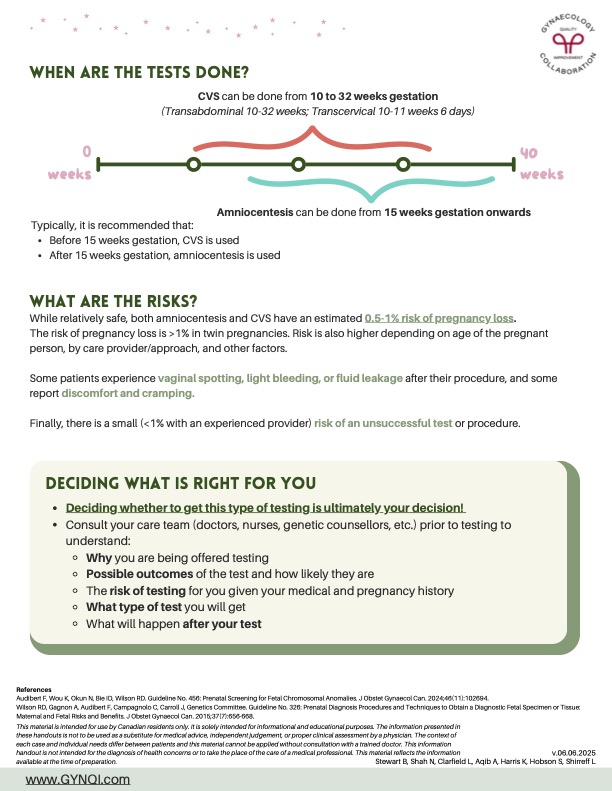Chorionic Villus Sampling & Amniocentesis
What is the Purpose of Chorionic Villus Sampling (CVS) and Amniocentesis?
CVS and amniocentesis are used to diagnose genetic disorders during pregnancy. This includes conditions like Down Syndrome. They may also be offered to test for certain genetic abnormalities that cannot be screened for through other tests (e.g., eFTS, MSS, NIPT).
CVS and amniocentesis may be offered to you if there is a higher-than-average chance that your baby has a genetic condition. Examples include:
- You have a family history of a genetic disorder
- You had a positive result on a screening test (e.g. ultrasound, blood test)
Note: Amniocentesis can be offered in some situations for reasons not related to genetic testing.
How Do the Tests Work?
- CVS and amniocentesis both involve collecting a small amount of fetal cells to get DNA
- An ultrasound is used to help the medical team see where to get the cells
- The tests are done such that typically no antibiotics nor anesthetic are needed
- After the procedure, it is recommended to take it easy for 12-24 hours
- Results are typically available 1-3 weeks later but this will depend on the testing being done.
CVS
- Cells come from the placenta
- The sample is collected using:
- A needle through the pregnant person’s abdomen and uterus (“transabdominal CVS”)
- The more common approach!
- OR
- A catheter (tube) through the vagina and cervix (“transcervical CVS”)
- A needle through the pregnant person’s abdomen and uterus (“transabdominal CVS”)
- The cells can be used for DNA testing
Amniocentesis
- Cells come from the amniotic fluid that surrounds the fetus
- The sample is collected using a needle through the pregnant person’s abdomen and into the uterus
- The amniotic fluid can be used for DNA testing aND assessing amniotic fluid health
When Are the Tests Done?
CVS can be done from 10 to 32 weeks gestation (Transabdominal 10-32 weeks; Transcervical 10-11 weeks 6 days).
Amniocentesis can be done from 15 weeks gestation onwards.
Typically, it is recommended that:
- Before 15 weeks gestation, CVS is used
- After 15 weeks gestation, amniocentesis is used
What Are the Risks?
While relatively safe, both amniocentesis and CVS have an estimated 0.5-1% risk of pregnancy loss. The risk of pregnancy loss is >1% in twin pregnancies. Risk is also higher depending on age of the pregnant person, by care provider/approach, and other factors.
Some patients experience vaginal spotting, light bleeding, or fluid leakage after their procedure, and some report discomfort and cramping.
Finally, there is a small (<1% with an experienced provider) risk of an unsuccessful test or procedure.
Deciding What is Right for You
Deciding whether to get this type of testing is ultimately your decision!
Consult your care team (doctors, nurses, genetic counsellors, etc.) prior to testing to understand:
- Why you are being offered testing
- Possible outcomes of the test and how likely they are
- The risk of testing for you given your medical and pregnancy history
- What type of test you will get
- What will happen after your test





